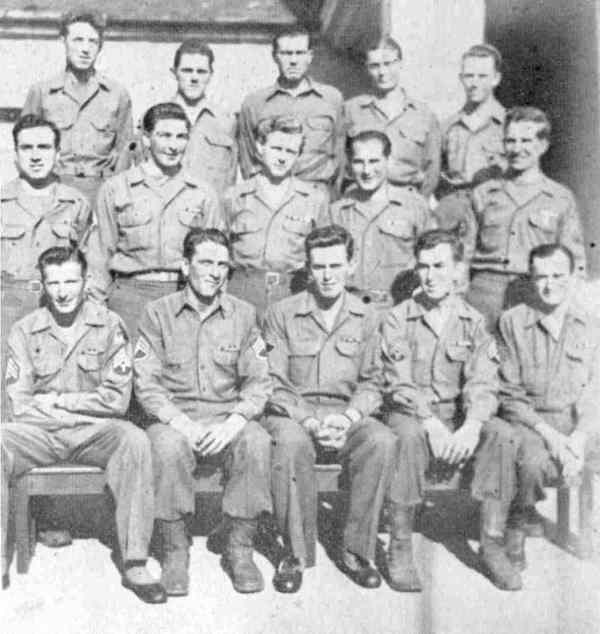Message Center and Radio Sections

Top row: Pvt. Thomas L. Jones, Pvt. Jarnes M. Callison, Cpl. Troy F. Sewell, Pvt. James A. Ainsworth, Tech. 4 Robert L. Davis.
Middle row: Pfc. Salvatore Grillo, Tech. 5 Conrad R. Suprenant, Tech. 5 Raymond H. Hulsey, Tech. 5 Leon H. Papazian, Tech. 5 Howard T. Muraski.
Bottom row: Tech. 4 Lyle E. Clevenger, Staff Sgt. Glen M. Heckart, Staff Sgt. Peter A. Flannery, Tech. 4 John R. McMichael, Cpl. Peter E. Balbier.
The team which worked most diligently to keep our messages a secret to the enemy was the radio-message center combination. Dissemination of information to lower echelons and liaison with higher and lower echelons is a primary function of Message Center. There were many times when locations of units were not exactly known, or the units were on the move; it was then that the radio section put through the vital information. Like all good teams, such plays were reciprocal. Message Center spent no little time in encoding and decoding messages. No small credit must be given to those men who served as Liaison Corporals. Upon them rested the burden of responsibility for delivering the goods. Deep was the snow, soggy the mud, and wet the rain--to say nothing of shell fire and small arms fire--these men rode through to deliver their messages. The Message Center crew was one of the many small super crews that functioned in combat. Crew chiefs were S/Sgt. Russel G. Hunter and S/Sgt. Peter A. Flannery.
The Radio Section, frequently undermanned and always overworked, has to its credit a record of miraculous performances. Doing an assigned job under combat conditions is difficult enough, but the boys of the Radio Section went beyond prescribed duties. Unusual, creative abilities of the Chief of Section S/Sgt. Glen M. Heckart and his crew resulted in a unique system of remote controls which heightened the effectiveness of radio as a media for the transmission of fire missions. A total of six nets were operated constantly during a twenty-four hour period, Division G-2 net by Tec. 5 Papazian, the G-3, Div. Arty. Command net by Tec. 4 Davis, G-4 and S-4 by Tec. 5 Fredericks, S-3 and Battalion Fire Direction by Tec. 4 Clevenger, and the Corps Artillery net by Pfc. Grillo. A sample of a day's traffic revealed that an excess of eighty messages was cleared through these radio nets, the bulk of these being transmitted through the G-2 net.
The knowledge that a German counterattack in the Bastogne area was broken up by the artillery gave these operators their biggest thrill. They had an almost eyewitness account of it. They were the first to receive the word--and then they transmitted the fire missions.
To date the section boasts of a record of continuous operation, having operated constantly since landing on the beaches of France in the latter part of July, 1944.
NOTE: Remove question mark from address below when sending email
This page is maintained by Bruce Frederick, EMAIL .
Last updated: March 2, 2002
